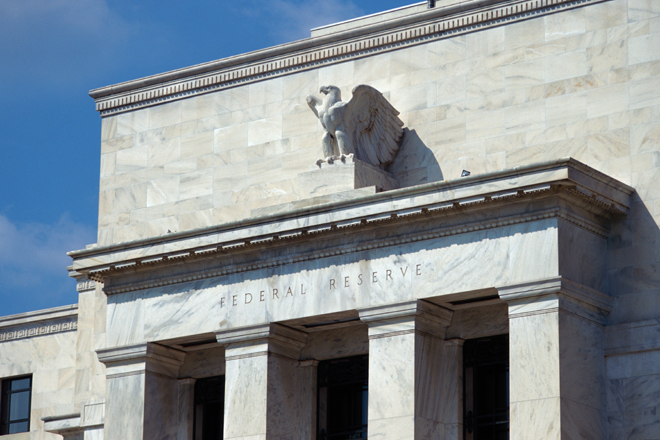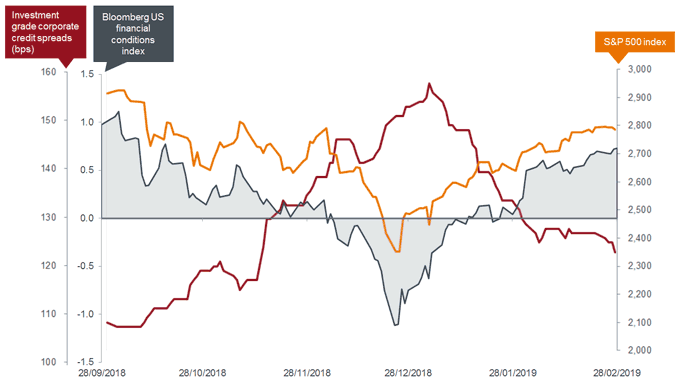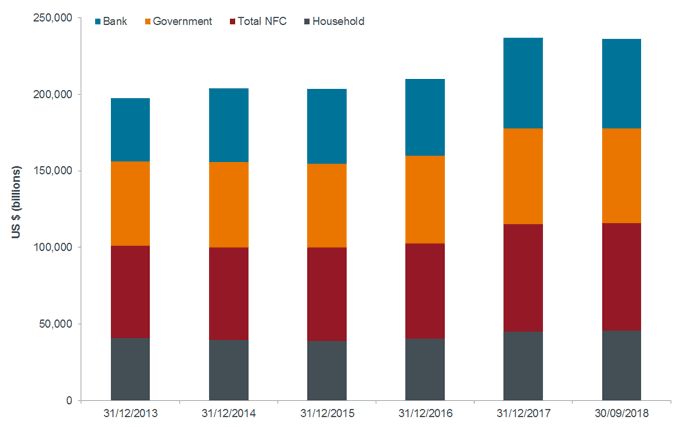Fed pivot slows advent of cycle’s end

US Fixed Income managers, Darrell Watters, Mayur Saigal and Mike Keough, discuss what the US Federal Reserve’s newly dovish stance means for markets.
The market volatility of the fourth quarter of 2018 has generally blown over, and risk asset valuations are climbing again. The US Federal Reserve (Fed), in our view, is at the very centre of this shift. The Fed’s recent pivot to a more dovish stance has effectively calmed market volatility and will, in our view, further extend the economic and credit cycles.
Hawkish talk sends markets tumbling
Just a few months ago, the Fed was working hard to replenish its coffers in preparation for the next downturn. Monetary policy was still “a long way from neutral” in October, according to Chairman Jerome Powell, and despite slowing growth in the US and abroad, the Fed raised interest rates in December. It was the ninth hike in the current tightening cycle, raising the Fed’s benchmark rate to the 2.25% to 2.50% range from 0% to 0.25% in 2015. Powell touted the strength of the US economy and forward guidance suggested we’d see at least two additional interest rate increases in 2019, when markets saw rationale for none.
The fourth quarter also marked peak velocity for the central bank’s balance sheet runoff, wherein approximately $50 billion worth of Treasuries and government agency mortgage-backed securities were due to mature without reinvestment each month. Deemed quantitative tightening, this roll-off of assets reduces excess reserves in the banking system, forcing banks to find alternative funding, which should ultimately drive short-term lending rates higher. Powell stated that the balance sheet runoff was on “automatic pilot” in December, further disappointing markets.
The cumulative effect of the Fed’s tightening, coupled with fear of policy error, brought on a fast and furious bout of volatility at year-end. Equity markets plunged and corporate bond spreads widened dramatically over the yields of their comparable risk-free benchmarks, driving equity and debt funding costs higher. As financial conditions tightened, many investors – us included – began to question how much longer the economic and credit cycles could continue.
A dovish pivot
Despite GDP growth advancing an annualised 2.2% in the fourth quarter, and corporate earnings growth registering a multi-year high, 93% of assets generated a negative total return for 2018 in US dollar terms, according to a Deutsche Bank study. The market’s reaction to Fed policy did not go unnoticed.
On 3 January, Powell acknowledged markets were “sending signals of concern” despite generally positive US economic data. In a dovish pivot, Powell added that the Fed “will be patient” as it watches the economy evolve. January’s meeting of the Federal Open Market Committee, the Fed’s policy making body, reiterated the central bank’s newfound patience, implying that it might not raise interest rates at all in 2019 which sent markets climbing once again (chart 1). Meeting minutes also disclosed that Fed officials were ready to stop culling the central bank’s balance sheet this year, roughly two years earlier than expected and $1 trillion shy of what was anticipated. In March, the Fed confirmed it would remain on pause this year, and that it would cease its balance sheet runoff in September.
CHART 1: Fed talk moves markets
[caption id=”attachment_73543″ align=”alignnone” width=”680″] Source: Bloomberg, as at 28 February 2019 Notes: Corporate spreads represent the Bloomberg Barclays US Aggregate Corporate average option-adjusted spread (OAS). OAS measures the spread between a fixed income security rate and the risk-free rate of return, which is adjusted to take into account an embedded option. 100 basis points equals 1%. Financial conditions represents the Bloomberg US Financial Conditions Index. The Bloomberg US Financial Conditions Index tracks the overall level of financial stress in the US money, bond and equity markets to help assess the availability and cost of credit. A positive value indicates accommodative financial conditions, while a negative value indicates tighter financial conditions relative to pre-crisis norms.[/caption]
Source: Bloomberg, as at 28 February 2019 Notes: Corporate spreads represent the Bloomberg Barclays US Aggregate Corporate average option-adjusted spread (OAS). OAS measures the spread between a fixed income security rate and the risk-free rate of return, which is adjusted to take into account an embedded option. 100 basis points equals 1%. Financial conditions represents the Bloomberg US Financial Conditions Index. The Bloomberg US Financial Conditions Index tracks the overall level of financial stress in the US money, bond and equity markets to help assess the availability and cost of credit. A positive value indicates accommodative financial conditions, while a negative value indicates tighter financial conditions relative to pre-crisis norms.[/caption]
We would argue this shift harkens back to the Fed’s unspoken mandate of financial market stability. Maximum employment and stable prices – the central bank’s stated mandates – are in hand, with the unemployment rate at 3.8% (Bureau of Labor Statistics, as at February 2019) and inflation just below the Fed’s 2% target (Bureau of Economic Analysis, as at December 2018). What was clearly not in hand in December was market stability – a key element of consumer confidence. As the Fed seeks to engineer a soft landing for this economic cycle, the fact that consumer spending represents approximately 70% of US GDP (Bureau of Economic Analysis, as at Q4 2018) is surely top of mind.
We would be remiss not to mention the sheer volume of outstanding debt, which likely also weighs on the minds of Fed officials. As seen in chart 2, US national debt represents approximately 9% of the $236 trillion of global debt outstanding (Bank of International Settlements, as at Q3 2018) – a figure that has ballooned amid low borrowing costs and stimulative monetary policy. Economic growth is crucial to servicing and paying down debt. Without growth, those figures could take a recession scenario from bad to worse.
CHART 2: Global debt growth
[caption id=”attachment_73554″ align=”alignnone” width=”680″] Source: Bank of International Settlements, as at 30 September 2018. NFC = non-financial corporation.[/caption]
Source: Bank of International Settlements, as at 30 September 2018. NFC = non-financial corporation.[/caption]
The likelihood is high that the full impact of the Fed’s tightening has not yet come to pass, which begs the question: How much more volatility would we see if the Fed pushed on with its normalisation programme? We believe that the combination of these factors spurred the Fed’s 180-degree turn. Without inflation knocking, the Fed can afford to pause, take stock of US economic conditions and assuage investor fears. So far this year, it has done all three. Financial conditions have eased as market participants sigh with relief that the Fed is paying attention to asset prices. In the first three months of the year, US equities generated double-digit returns and retraced much of the fourth quarter’s losses. Credit spreads that had blown out to levels last seen in 2016 are once again encroaching on the tightest levels of this credit cycle. The Bloomberg Barclays US Credit Index returned close to 5%, and the Bloomberg Barclays US High Yield Corporate Index returned over 7%.
What about the inversion?
As for the yield curve, an inversion (in which longer-dated securities yield less than shorter-dated securities) should not be taken lightly, given each of the last major recessions was preceded by one. However, an inversion does not necessarily portend recession. Inversion indicates a view of a slowing economy and a lower path for future rates, but it is only one factor, among many, that must be analysed in terms of a recession watch.
The recent inversion of the 3-month to 10-year portion of the yield curve was primarily attributable to the rapid repricing of the path of forward rates. The Fed’s March affirmation of its plans to hold rates steady – which suggests its current hiking cycle is complete – put downward pressure on the long end of the curve, while the front end remains pinned by the federal funds rate. A notion that inflation is generally contained supports the view that the Fed can remain on pause, and that rates can remain range-bound to lower. Further pressure on the long end of the curve is emanating from low-to-negative yields abroad. US rates remain relatively attractive versus global yields, a circumstance that is holding down rates more so than in the past.
These factors, coupled with other currently constructive market indicators, including the aforementioned momentum in credit spreads and equities, lead us to believe that the US economy still has room to run, albeit at a slower pace.
Stablisation pending
We don’t expect the US economy to reaccelerate, but as fears of Fed policy error recede, growth could feasibly stabilise in the 2% to 2.5% range. Given that the best days of both the economic and business cycle are likely behind us, more tempered growth would be appropriate, particularly when we consider that part of last year’s robust corporate performance was due to late-cycle US fiscal stimulus. While 2018 was the strongest year for top-line growth since 2010, President Trump’s tax package is credited for roughly 40% of it.
A flurry of debt-funded stock buybacks have also fuelled higher earnings growth over the last few years. As risk premiums return, borrowing costs have risen, and we expect management teams to exhibit a more restrained approach to buybacks, which would further moderate earnings growth. Indeed, analysts are projecting S&P 500 Index earnings growth to be negative in Q1, flat for Q2 and just 3.7% for calendar year 2019 versus 20.5% for 2018 (FactSet, March 2019). Clearly, earnings estimates are accounting for slowing conditions. However, fundamentals remain constructive and once the full scope of the Fed’s tightening has worked through the system, we anticipate earnings growth will stabilise again. The rally in the 10-year, which declined over 80 basis points, or 0.80%, from early November to end of March, should also create a tailwind for housing and other rate-sensitive sectors. Additionally, the consumer remains in a healthy spot amid a strong jobs market and modest upward wage pressure.
Positive developments on the geopolitical front could lend further support to the US outlook. China’s slowing economy, unresolved US-China trade disputes and the impact of both on global growth stressed markets last year. However, Beijing’s recent stimulus package coupled with a stall in planned tariff increases on Chinese goods entering the US could help to stabilise China’s slowdown, as could a favourable resolution to trade negotiations. The avoidance of a hard Brexit, a scenario in which the UK would leave the European Union’s single market, also appears more likely and would be positive for trade and global growth. Monitoring these developments and their impact on global purchasing managers’ indices (PMIs) will be critical in the months ahead to see whether global and US growth can truly stabilise.
Vigilance still required
While there are many factors to keep an eye on, benign inflation and an accommodative Fed should help US economic growth to stabilise at a relatively healthy level, which should in turn help to extend the economic and credit cycles and keep the threat of recession at bay, at least in the near term. Amid this constructive but more reserved backdrop, we anticipate a range-bound marketplace, but we are mindful that corporate valuations generally already reflect these positive developments. Further, timing a recession is inherently challenging and investors must remain vigilant for signs of late-cycle stress.
At this stage of the cycle, we believe there is benefit to considering broad diversification across fixed income asset classes and a more conservative securitised and corporate credit allocation, as opposed to the earlier stages of the cycle when both fundamentals and valuations tend to be tailwinds. When seeking to capitalise on attractively valued potential sources of excess return within corporate credit, we believe it prudent to focus on companies committed to balance sheet improvement, while avoiding those that continue to exhibit more equity-friendly behaviour, such as engaging in debt-funded buybacks or mergers and acquisitions. This is also the time in the cycle to look to more defensive business models that have the potential to generate consistent free cash flow, even if a downturn unfolds.
These are the views of the author at the time of publication and may differ from the views of other individuals/teams at Janus Henderson Investors. References made to individual securities do not constitute a recommendation to buy, sell or hold any security, investment strategy or market sector, and should not be assumed to be profitable. Janus Henderson Investors, its affiliated advisor, or its employees, may have a position in the securities mentioned.
Past performance does not predict future returns. The value of an investment and the income from it can fall as well as rise and you may not get back the amount originally invested.
The information in this article does not qualify as an investment recommendation.
There is no guarantee that past trends will continue, or forecasts will be realised.
Marketing Communication.
